#sestet
Text

"Whimsy's Muse" - a poem written 4/10/2024
3 notes
·
View notes
Text
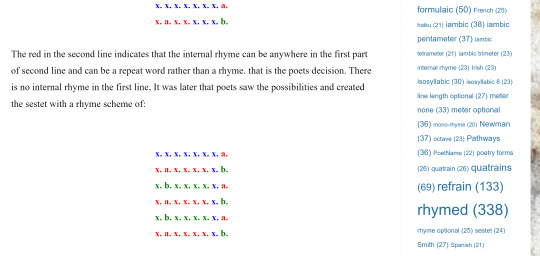
Sestet
I enjoyed falling off the script by exploring a different poet in the earlier post and so thought I'd stay with that mood by writing off-prompt - I mean, that perhaps seems counter-productive if the point is to re-run the NaPoWriMo prompt challenges...
But - they're always framed as optional - and looking back, I see I had high fun and high drama first time round, writing A Tirade Of Eggs (a breakfast rant from an egg's-eye perspective...).
So - something different today -
And especially because I've read something this morning that genuinely inspired me, something around when it's useful to coin new vocabulary - or find or adopt fresh language for something.
I think I've always tended to want to take on new terminology only after I've demonstrated to myself that I actually know what it means. And the simplest way I know to do that is to use other words - simpler words, in their ordinary everyday usage - to explain it.
(These days, remembering what something means is NOT a "onefer" experience, i.e., I frequently have to look the same word up over and over again - as I did with the word "palimpsest", mentioned recently. Thanks to this blog, I think I've mastered that one but for how long??)
I decided to try to work with a Sestet. As explained on the poetry forms website below, this is a version of a six line poem taking inspiration from George Herbert who in turn is believed to have nicked it from the Welsh. It involves using the end word of one line as an internal rhyme in the next line, so that in each line other than the first, there's both an internal and external rhyme in every line.
So I give you -
Knowing: A Sestet
First attempt -
The way I know I know a thing
is bringing language of my own,
loan a frame to shape my thinking,
ring a sound I’ve always known –
but not known here. And if it sings,
I know I live this thing I know.
Second attempt (I think - better) -
This way I know I know a thing -
I bring in language of my own,
a frame-on-loan to hold my thinking,
ringing a tone I’ve always known,
but not known here. And as it sings,
it sings me home, this thing I know.
0 notes
Text
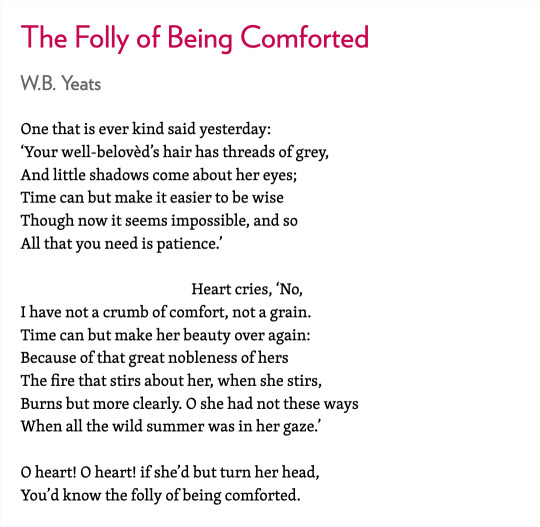
#don't ask me how i ended up here ('was it a fic‚ K?' 'yes‚ obviously it was a fic.') but#this poem somehow makes me think of plath's 'black rook in rainy weather'#not because the poems are at all similar but because it's that feeling of a dull ruinous landscape suddenly illuminated#like. the sestet here is SO workmanlike and wearisome#yesterday. grey. eyes. wise. 'one that is ever kind' right okay you're making up the syllable count. etc etc#and then—'the fire that stirs about her‚ when she stirs‚ / burns but more clearly.'#'o she had not these ways / when all the wild summer was in her gaze.'#like. my god.#the sudden wild white beating of swan's wings. the lift of my battered enraptured heart.#anyway. 'did you know famous poet william butler yeats had his moments‚ actually??' you heard it here extremely not first.#(i mean. that said—imagine writing a poem that ascribed any qualities to a woman you couldn't reassign to a horse.)#(like. billy boy. do you love anything about her but her beauty and her ~spirit~. is she intelligent. is she funny. is she fiercely moral.)#(ah well.)#poetry#w.b. yeats
60 notes
·
View notes
Text
Oct. 25 Prompts: Superstitions
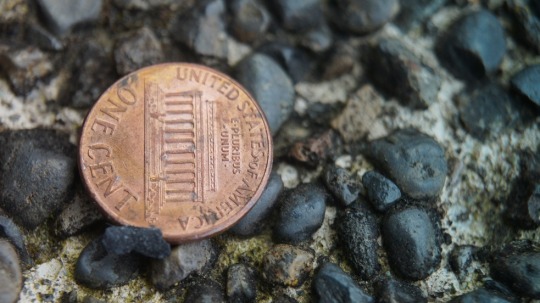
View On WordPress
#OctPoWriMo#Writober#creative challenges#fun#Halloween#horror#Mirror Sestet#October challenges#OctPoWriMo 2023#poetry forms#Superstitions#Writober 2023
0 notes
Note
well i just graduated college, so of course the first thing i do is hop back on here! so, question for mr. sonic: what's the difference between an english sonnet and an italian sonnet?
Ooooo! Congratulations on graduating!

To answer your question! The difference between English sonnets and Italian sonnets are their rhymes! Italian sonnets have an octave rhyming abba abba, and a sestet usually rhyming cdcdcd or cdecde. English sonnets on the other hand has a rhyme scheme abab cdcd efef gg.
#sonics schoolhouse#student question#ssliterature#sonic the hedgehog#sonic#sonic fanart#sonic the hedghog fanart#education#mr. sonic
9 notes
·
View notes
Text

here is a list of different poetic forms that might help you get started if you’re feeling a bit stumped, unsure, or it might give you a challenge if you want to try something new! <3
Blank verse: Blank verse is poetry written with regular metrical but unrhymed lines, almost always in iambic pentameter.
Examples:


Villanelle: The villanelle is a nineteen-line poetic form consisting of five tercets (3 lines) followed by a quatrain (4 lines). There are two refrains and two repeating rhymes, with the first and third line of the first tercet repeated alternately at the end of each subsequent stanza until the last stanza, which includes both repeated lines.
Examples:
do not go gentle into that good night by dylan thomas
10 villanelle poem examples to study
Haiku: The haiku is of ancient Japanese origin. It usually contains 17 syllables in 3 lines of five, seven, five (though modern examples do not systematically follow that pattern). Haiku poems typically contain references to nature.
Examples:
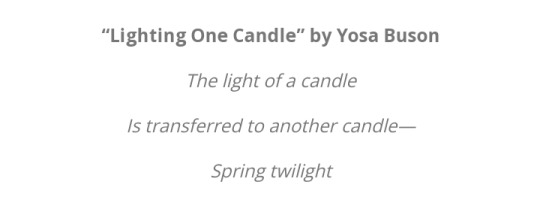
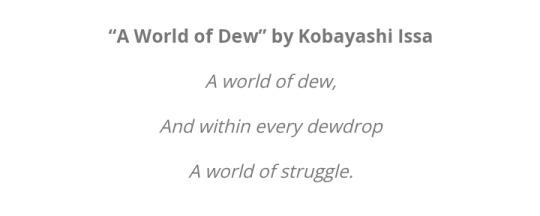

Sonnet: Traditionally, the sonnet is a fourteen-line poem written in iambic pentameter, employing one of several rhyme schemes, and adhering to a tightly structured thematic organization. The two main types of sonnets are the following:
• Shakespearean (or English) sonnet: three quatrains (4 lines) and a couplet (2 lines). Rhymes are ABAB, CDCD, EFEF, GG
• Petrarchan (or Italian) sonnet: divided into two stanzas, an octave (8 lines) followed by a sestet (6 lines). Rhymes are ABBAABBA + CDECDE or CDCDCD
Limerick: A limerick is a form of verse, usually humorous and frequently rude, in five-line, predominantly anapestic trimeter with a strict rhyme scheme of AABBA, in which the third and fourth lines are typically shorter.
Examples:


Elegy: A melancholy poem that serves the purpose of a lament for or a celebration of a deceased person.
Examples:
Elegies, Book One, 5 BY CHRISTOPHER MARLOWE
Lycidas, BY JOHN MILTON
Because I could not stop for Death, BY EMILY DICKINSON
Ode: An ode is a lyrical poem that expresses praise, glorification, or tribute, with the subject matter being a person, event, or idea. Classic odes contain three sections: a strophe, an antistrophe, and an epode—effectively a beginning, middle, and end.
Example:
Ode on a Grecian Urn, by JOHN KEATS
Concrete poem: Also known as visual poetry, it is essentially poetry which is shaped in a certain way which adds to its meaning.
Found poem: Found poetry is a form of poetry in which you create a poem by cutting up, remixing, or otherwise transforming an existing piece of text. (you can use dialogue from the show/scripts?)
Blackout poetry: Blackout poetry is the process out taking an already existing piece of text and blacking out the words save for a few select ones that take on new meaning.
#writing#writing poetry#poetry resources#poetry#poetic forms#how to write a poem#writing resources#resources#insp#buddie poetry event#poemsbybuddie
81 notes
·
View notes
Text
In the interest of challenging myself to new things, I signed up for Storytelling Collective's April Daily Poem challenge. I am not a poetry person! This despite my partner having an actual degree in (form) poetry. Anyway it's only 14 days right, I am strong, I can do this. It's good to learn new things!
This year StoCo themed their prompts around an upcoming album for an artist I've got no connection with, so I went and made a Carly Rae Jepsen song title generator to use instead.
Anyway! I am being brave and I'll just share them here? I cannot promise they'll be good but that is what learning is. Anyway posting here the next day for 'em.
-
Feels Right (04/01/24)
It's *easy* enough to write a formula or code,
that kind of language as math, to produce some
feeling|energy|result|user outcome,
plotting out the branches of a story's webb'd road.
And it's not as if this particular mode
of folding words so they select [value] from
[a known table of action and emotion]
is a language thing so completely ~unknowed~.
Though it's not so bad to read a sestet rhyme scheme,
CDCDCD, and recognise grey.
Other options deliver soft mint, sage green.
To find things, however tenuous, that may
allow the mind a structure or things that seem
familiar enough that it invites one to play.
9 notes
·
View notes
Text
To everyone that cares: the fairy tale a day thing is, for better or worse, alive and well. 74 little stories in, and counting! The poem a day thing really fell off, but there’s something about the end of spring and limericks that don’t seem to gel well (at least for me). Still managed to write 31 of them, just not each and every day of May, which was kind of a rough psychic patch apparently.
For June, it’s sestets, and maybe an occasional sestina (they’re pretty involved, so I don’t know if I could write one a day even if I wanted to). Six isn’t a popular thematic number for anything other than the end of a sonnet or sestinas, apparently.
#I know I’m mainly talking to myself but I also have friends on here that I don’t really see anywhere else#so this is for you guys 💕#on writing
2 notes
·
View notes
Text
Hmmmm
Now I want to complete the sestet and give them all wings
#i’ll wait for season 3#because it has to be the big moments#i know what i’m doing for hunter already though and it HURTS
1 note
·
View note
Text
Sonnet to Sonnet
When i wrote you did i know what you were?
Petrarchan sonnet, octave and sestet
Perhaps the old great poets I had met
But time has caused my memory to blur.
And did I then to poets old refer?
Or did I think that none had written yet
In this one pattern, octave and sestet?
In ABBA rhyme schemes I prefer?
But why is this important in my mind?
No matter if I inspiration found;
The joy is knowing now what then I wrote.
My volta in the sestet you may find
In iambic pentameter the sound,
And in the enclosed rhyme caught in my throat.
3 notes
·
View notes
Text
RIGHT YEAH THEY BOTH HAVE FOURTEEN LINES BUT ONE IS THREE QUATRAINS AND A COUPLET AND ITS ABABCDCDEFEFGG AND THE OTHER ONE IS AN OCTAVE AND A SESTET USUALLY WITH A CONCEPTUAL TURN. OR VOLTA, IN THE MIDDLE—COULD BE BEFORE LINE 9 OR EVEN IN THE MIDDLE OF LINE 9 BUT THAT ONE GOES ABBA ABBA CDE CDE OR EVEN ABBAABBA CDCDCD OR EVEN CDCCDC I KNOW CRAZY AND HE WROTE THEM IN ITALIAN FOR LAURA BUT WAIT TILL YOU HEAR ABOUT THE TERZA RIMA

2 notes
·
View notes
Photo
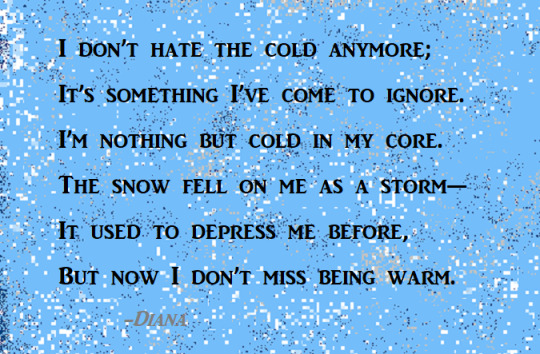
“Warmed Up to It” - a sestet written 3/04/2015
#2015#hs sophomore#sestet#catalectic amphibrachic meter#amphibrachic trimeter#anapestic meter#anapestic trimeter#i didn't know much about non-iambic meters at this time other than how to write a double dactyl. but that's clearly what i went for#and it's pretty consistent so damn good job little diana#poetry#poets on tumblr#teen poetry#depression#i guess i gotta tokenize my mental illness for a few clicks
8 notes
·
View notes
Text
Night of the Lonely Dead
I’m still looking through a book on writing poetry and looking through a section on sources of inspiration. I just looked through a chapter on death and grief. Among the options for writing exercise, I chose one in which I would imagine what the dead do and feel in their afterlives. Again, I experiment with tweaks on the ballad form, which uses tail rhymes on alternating lines, though here I juxtapose tercets within sestets. Also, how would you say my repetitions of “lonely dead” and “veil” turned out here?
The lonely dead barely see through the veil,
Hazy and darkened and foggy and rippling.
They still desire to tell their entire tales
And show their faces to those who are willing to see.
It seems as if only psychics, shamans,
Witches, and lunatics sense the dead clearly.
The lonely dead attempt to grip attention
By imposing chills, nudging objects,
And scrambling radio signals across dimensions,
Across the veil, with barely any force.
Men of science understandably dismiss
Any discussion of spirits as asinine folklore.
The lonely dead watch the living on our side
Of the veil continue giving hugs,
Watching chirping robins, and drinking chai.
They wait to be healed and freed to rest in peace.
Befriending the dead is worth a try,
Possibly resulting in mutual deep relief.
#original poetry#original poem#verse#poetry#poem#poetry on tumblr#poets on tumblr#ghosts#paranormal#spirits#hauntings#haunted house#lonely#death#dead#afterlife
0 notes
Text
i only ever experience dawn from the wrong side but even so there's always something at least a little heart-lifting abt the imperceptible yet inexorable paling of the world (ey says, having managed to describe it in a way that instead makes it sound like a fascist social manifesto) and the first determined little bird calling out like a newspaper guy <3
#i was like 'it's like that one richard wilbur pome!' but then i looked up the richard wilbur pome in question and. memory lies actually#but something abt my mental image of that pome always makes me think of like. wet white bedsheets hanging translucent in dawn light#except like. in the courtyard of a city apartment building where no one would ever hang sheets#with pigeons flying up because—who knows why. because the image needs fat sweet little birds with their dirty-dove wings.#just like. the grimy world turns on and the light still—still!—rises over it#and we lift our faces damp and hopeful‚ new-washed by morning#…hopkins god's grandeur sestet basically.#or like. plagal cadence but emotionally.#moodblogging#i guess lmao
8 notes
·
View notes
Text
How do I love thee? by Elizabeth Barret Browning
A close reading of Elizabeth Barret Browning’s 1891 poem titled, “How do I love thee?” reveals that it is also constant, boundless, and eternal. This paper would argue that Browning’s poem is a reckoning of the attributes of true love.
The poem, “How do I love thee is a petrachan sonnet made up of the traditional 14 lines divided into two sections of rhyming octave and sestet, with ABBA ABBA…

View On WordPress
1 note
·
View note
Text
Louise Walker, 'Octave/Sestet'
With each deep breath, the flute will utter prayer, its voice vibrating with the purest note of G in the first octave. Then you can float up to the next because you know it’s there. The painter knows how to balance sea and air, concealing rules that have been learned by rote; the same that give the poet secret hope that all will be in order, nothing spare. But look – the sunflower makes a perfect…

View On WordPress
0 notes